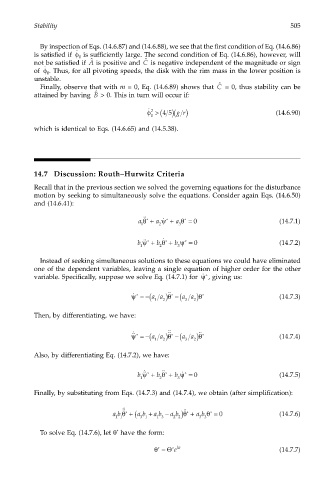Page 524 - Dynamics of Mechanical Systems
P. 524
0593_C14_fm Page 505 Tuesday, May 7, 2002 6:56 AM
Stability 505
By inspection of Eqs. (14.6.87) and (14.6.88), we see that the first condition of Eq. (14.6.86)
is satisfied if φ ˙ 0 is sufficiently large. The second condition of Eq. (14.6.86), however, will
ˆ
ˆ
A
C
not be satisfied if is positive and is negative independent of the magnitude or sign
of φ ˙ 0 . Thus, for all pivoting speeds, the disk with the rim mass in the lower position is
unstable.
ˆ
Finally, observe that with m = 0, Eq. (14.6.89) shows that C = 0, thus stability can be
ˆ
B
attained by having > 0. This in turn will occur if:
φ > ( )
˙ 2
0 45)(gr (14.6.90)
which is identical to Eqs. (14.6.65) and (14.5.38).
14.7 Discussion: Routh–Hurwitz Criteria
Recall that in the previous section we solved the governing equations for the disturbance
motion by seeking to simultaneously solve the equations. Consider again Eqs. (14.6.50)
and (14.6.41):
ψ +
a θ + a ˙ * a θ = 0 (14.7.1)
˙˙*
*
1 2 3
ψ +
b ˙˙ * b θ + b ψ = 0 (14.7.2)
*
˙ *
1 2 3
Instead of seeking simultaneous solutions to these equations we could have eliminated
one of the dependent variables, leaving a single equation of higher order for the other
ψ
variable. Specifically, suppose we solve Eq. (14.7.1) for ˙ * , giving us:
ψ =−(aa θ ) ˙˙* −(a a θ ) * (14.7.3)
˙ *
1 2 3 2
Then, by differentiating, we have:
˙
ψ =−(aa θ ) ˙˙ −(a a θ ) ˙˙* (14.7.4)
˙˙*
˙˙ *
1 2 3 2
Also, by differentiating Eq. (14.7.2), we have:
˙
ψ +
ψ =
˙˙*
b ˙˙ * b θ + b ˙ * 0 (14.7.5)
1 2 3
Finally, by substituting from Eqs. (14.7.3) and (14.7.4), we obtain (after simplification):
a b θ + ( ab + a b − ab θ ) ˙˙* + ab θ = 0 (14.7.6)
˙˙
*
˙˙*
1 1 3 1 1 3 22 33
To solve Eq. (14.7.6), let θ have the form:
*
θ =Θ e λt (14.7.7)
*
*

